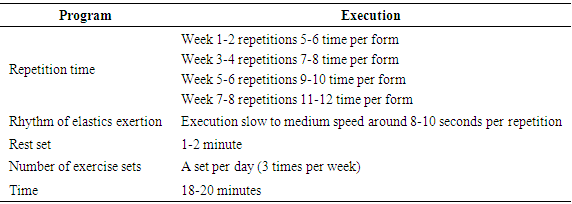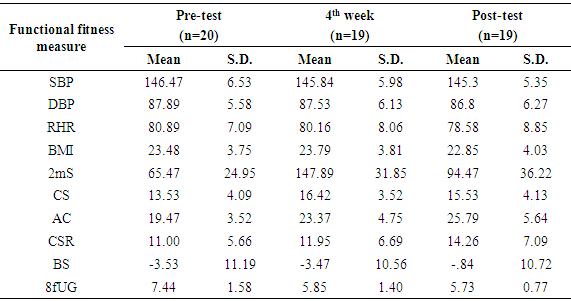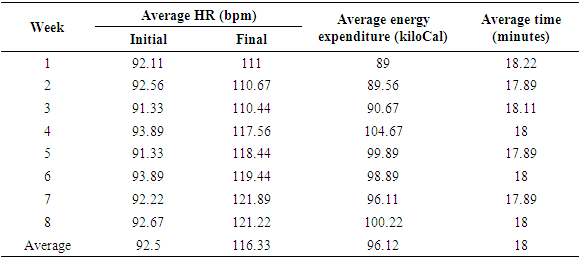-
Paper Information
- Paper Submission
-
Journal Information
- About This Journal
- Editorial Board
- Current Issue
- Archive
- Author Guidelines
- Contact Us
International Journal of Sports Science
p-ISSN: 2169-8759 e-ISSN: 2169-8791
2017; 7(6): 209-214
doi:10.5923/j.sports.20170706.01

The Development of an Elastic Tube Exercise Program for Chronically Ill Older Adults
Chatkamon Singnoy1, Pronchai Julamet2, Ouaypron Tungthongchai3
1Faculty of Sport Science, Burpha University, Thailand
2Faculty of Nursing, Burpha University, Thailand
3Faculty of Education, Kasetsart University, Thailand
Correspondence to: Chatkamon Singnoy, Faculty of Sport Science, Burpha University, Thailand.
| Email: |  |
Copyright © 2017 Scientific & Academic Publishing. All Rights Reserved.
This work is licensed under the Creative Commons Attribution International License (CC BY).
http://creativecommons.org/licenses/by/4.0/

The purpose of this study was to design, develop, and apply an elastic tube exercise program for chronically ill older adults and to investigate the efficiency of the program on their physical fitness. This study is divided into two parts. Part 1 develops the program by reviewing the literature on exercise gerontology. Fourteen exercise forms were designed and, after two cycles of expert suggestion and modification, the program was reduced to 11 forms. The index of item-objective congruence was 0.81. A trial with one older adult subject studied the efficiency and reliability of the program. The energy expenditure was 59.5 Kilocalories; the heart rate average was 88.5 beats per minute, and exercise intensity was 56.75%. Moreover, the reliability was 0.94. The program showed good validity and reliability. Part 2 studied the efficiency of the program with 19 female older adult volunteers who live in the Saen Sook municipal district. The average age was 69±5.77 years; average height was 154.32±4.24 centimeters; body mass index was 23.48± 3.77 kg/m2; systolic blood pressure average was 146.47±6.53 mmHg, and the diastolic blood pressure average was 87.89±5.58 mmHg. The participants were diagnosed with high blood pressure level 1 at the hospital. The research method was experimental for eight weeks with 11 forms of applied elastic tube exercise, one group pre-test/post-test design. The Senior Fitness Test was used before, during, and after the experiment. The participants showed decreased systolic blood pressure, resting heart rate, and body mass index, which was significant at 0.05. The program increased the two-minute step performance, muscle strength, and flexibility, which was significant at 0.05. Improvements in balance and agility were significant at 0.05. The data showed no improvement in diastolic blood pressure. In conclusion, the applied elastic tube exercise program was a tool which can be used for exercise with chronically ill older adults.
Keywords: Elastic Tube Exercise Program/ Exercise for Chronically Ill Older Adults
Cite this paper: Chatkamon Singnoy, Pronchai Julamet, Ouaypron Tungthongchai, The Development of an Elastic Tube Exercise Program for Chronically Ill Older Adults, International Journal of Sports Science, Vol. 7 No. 6, 2017, pp. 209-214. doi: 10.5923/j.sports.20170706.01.
Article Outline
1. Introduction
- The world’s population is aging rapidly. Between 2015 and 2050, the proportion of the world's oldest adults is estimated to almost double from about 12 percent to 22 percent. In absolute terms, this is an expected increase from 900 million to 2 billion people over the age of 60. In general, older people need to be recognized, especially the physical and mental health challenges they face as they age. The growth of the elderly population in Thailand mirrors the global situation. The Institute for Population and Social Research, Mahidol University expects the number of individuals above 60 years in 2023 will increase to 14.1 million, representing around 21 percent of the Thai population. Thailand will become a “complete aging society.” Anusan Teanthong, general director of the Department of Older Persons in Thailand stated that older adults face health problems such as high blood pressure (41%), diabetes (18%), and knee osteoarthritis (9%). The elderly were at risk for many chronic illnesses until the government health care service increased its budget for this group. The most frequent chronic illnesses in the elderly are paralysis, diabetes, blood pressure conditions, dyslipidemia, obesity, and dementia; many of these conditions begin because people are moving less and not exercising. The number of inactive older Thais will increase dramatically, and activity levels generally decline with age [23]. Many of these chronic diseases can be prevented by regular exercise. Hiranrat [7] said that exercise has a significant role in improving both physical and mental health. Regular physical activity exercise provides a health benefit for older adults that includes improvements in blood pressure, diabetes, osteoarthritis, osteoporosis, and neurocognitive function. Regular physical activity and exercise show a strong association with a decline in disease and an increase in physical fitness among the elderly. Despite this, up to 75 percent of older Thais are not active enough to achieve these health benefits. One half of seniors cite musculoskeletal discomfort or disability as a reason for not exercising, along with balance problems (i.e., risk of falling), which leads them to decrease exercise activity. A number of older people decide not to exercise due to these limitations, but many older individuals remain healthy by exercising regularly. Aerobic exercise, strength training, and improved balance and flexibility are factors to improve and maintain good health. Physicians play a major role in motivating elderly patients and counseling them about physical limitations and diseases. They can motivate patients to begin exercise by focusing on individual goals, concerns, and barriers to exercise. Regular physical activity and exercise has been shown in significant data to decrease aging and maintain health in older adults [1-3].Stretching with elastic is a new exercise trend and an easy exercise for older adults. Research evidence supports stretching exercises with elastic as a way to decrease stress and improve health. The Thai government’s economic policy in 2007 proposed elastic exercises for improving muscle strength and endurance. The elastic band training program is used extensively in therapeutic areas due to its low cost, practicability, and portability. The elastic band is used for strength development [4]. Jakobsen, Sundatrup, Andersen, Aagaard and Andersen [9] reported that increased activity levels in the leg muscles were found with both the free weight method and the elastic band method. Similarly, Sundstrup, Jakobsen, Jay and Andersen [18] determined the increment of muscle activity with dumbbells, weight machine, and elastic band methods. In another study, Ghiradelli, Nagle, Gross, Robertson, Irrgang and Myslinski, [5] found maximal strength and explosive strength improvement in the elastic band group. An elastic band exercise is useful in general [10], but research has not investigated its use in chronically ill older adults who have health risks. Thus, the purpose of this study was to design and develop elastic tube exercises and to explore the effectiveness of an elastic tube exercise program on the physical fitness of chronically ill older adults.
2. Research Methodology
- This research and development investigation took place in two stages. The first part was to design and develop an elastics exercise program, and the second stage was to examine the effect of elastic tube exercise on chronically ill older adults. The research design was one group (pre-test/post-test design) because the sample was a small volunteer population. The 19 female volunteer participants were older adults between 60-80 years old. All participants were retired and involved with the Saensook municipality. This study promoted the exercise program for volunteers who had a symptom of chronic illness (in this study, the symptom was hypertension). Participants were clients of the public health care center and hospital in Saensook. The medical doctor diagnosed the participants as having hypertension disease and recommended light exercise for relieving disease and reducing the use of hypertension drugs. Also, the screening process used the PAR-Q questionnaire to check risk status before exercise.The criteria were high blood pressure symptoms (Systolic between 140-159 mmHg and diastolic between 80-90 mmHg), no injuries, no exercise in daily life, and no suspected complications or other health conditions such as kidney disease, cardiovascular disease, or cerebrovascular disease. At first, 40 participants were interested in the exercise program, but 15 individuals did not meet criteria. Twenty-five participants remained, and five withdrew because of difficulty in traveling to take part in the program. Two weeks into the trial, one participant withdrew from the program. The final number of participants was 19 females.Study 1 was the design and development of the elastics exercise program. A literature review was conducted to examine previous exercise programs for older adults with chronic disease conditions. The literature included a review of paper reports and research, websites, and interviews with older people who participated in programs at nine public parks in Chonburi Province. The review found that the elderly population struggles with knee immobility, weakness and lack of flexibility in the back, frozen shoulder, cardio-respiratory weakness, and chronic illness. The posture exercise program included exercises with elastic tubes to improve arm and leg strength, flexibility, frozen shoulder, and cardio-respiratory health. The validity and reliability of the tests were checked by an expert.Study 2 examined the effect of the elastic tube exercises on chronically ill older adults in the sample 19 female older adult volunteers in the Saensook municipal district. Participants exercised with an elastic tube over eight weeks. The sampling procedure was volunteer sampling. The physical effects were tested in the first week. The researcher explained and demonstrated the elastic tube exercise forms and provided a poster, guidebook, and DC (elastic tube exercise form clips). The participants exercised with the group and were tested at four weeks. The exercises continued to eight weeks, and participants were re-tested. Every week, the trainers monitored and motivated participants to exercise at home and use the Polar Heart Monitor FT7M to check heart rate and calculate total energy expenditure during exercise.Burapha University Review Board approved the research ethics.
3. Measurement Tools
- The tools in this research included: 1. The elastic tube exercise for chronically ill older adults program2. The PAR-Q screening questionnaire for checking physical status before exercise3. Weight scale, altimeter and measuring tape4. Pressure gauge (OMRON brand model SEM-1) to measure the systolic and diastolic blood pressure General physical information: Systolic (SBP) and diastolic blood pressure (DBP)1. Resting heart rate (RHR)2. Body mass index (BMI)Senior fitness test (to measure the functional fitness of older adults) [17]:1. Two-minute step test (2mS)2. Chair stand test (CS)3. Chair sit and reach test (CSR)4. Back scratch test (BS)5. Arm curl test (AC)6. Eight-foot up and go test (8fUG)
4. Research Analysis
- This research used a paired sample t-test to compare pre- and post-test results.
5. Result
- Fourteen exercise forms were designed in two cycles with five experts (2 sports scientists, internists, and therapists) testing content validity, suggestions, and modification, and finally the program consisted of 11 forms. The program followed the Frequency, Intensity, Time and Type (FITT) exercise principle. The amount of exertion increased two times every two weeks. The programs included a warm up and cool down period of 5-10 minutes before and after exercise. The program showed good validity and reliability.
|
|
|
|
|
|
6. Discussion
- The elastics exercise pattern was applied from a sports perspective, e.g., volleyball (volleyball under), Muay Thai (jab one-two and kicker front), kayak (paddling), golf (golf swing), football (kick the ball) weightlifting, billiards (pull the cue stick back) swimming (breaststroke kick and dolphin kick) and archery. After six weeks of training three times per week with resistive and stretching exercises, the result upheld efficiency to increase physical capacity and lower limb strength. Further, dramatic changes in blood pressure were also identified with a great reduction in diastolic blood pressure. It has been found that exercise is a good way to improve physical fitness, and it has a positive impact on blood pressure. These outcomes suggest that stretching played an important role in the reduction of diastolic blood pressure because resistive exercise alone was only sufficient in maintaining blood pressure during the six weeks of training. However, the combination of stretching and resistive exercise reduced diastolic blood pressure.The literature often describes the effects of stretching exercise programs on flexibility, range of motion, and mobility‒but not on the cardiovascular system. Moreover, some studies have used stretching as a control, neglecting its cardiovascular effect. Therefore, the outcomes of this study indicate that stretching should not be ignored in investigations of the cardiovascular system.An exercise pattern for older adults needs to integrate circuit training and elastics training to develop muscle strength and cardiovascular endurance. Srilamad [22] said that circuit training is a convenient exercise to enhance both cardiovascular endurance and muscle strength. That is a popular method to develop physical fitness, specifically when combined with resistance training.A literature review on the effects of elastic resistance training in older adults found positive outcomes in isometric, isotonic, and isokinetic muscle strength [16, 24, 11]. Moreover, elastic resistance training may be a more easily available and affordable exercise for older adults [25]. Resistance exercise with elastic tubing equipment has been used for almost a century [8]. The elastic devices, in both band and tube type, are an excellent, practical, and useful tool, and are low cost [19]. Exercise with elastic resistance has been increasingly used because it allows functional movement patterns and is more multipurpose and accessible for individuals. O'Shea, Taylor, and Paratz [13] said the most versatile characteristic of the elastic tube is the portability that allows training programs with both outdoor and indoor activity. Current research [6, 12, 14, 15, 20] reports an improvement in muscle function. These studies show that systematic use of elastic resistance devices has improved muscle strength and power, functional skills, and muscle mass. Stoppani [21] explains that elastic resistance devices were initially used as a fitness technique, but eventually progressed to be used as rehabilitation devices. Today, they are utilized in both fitness and rehabilitation facilities around the world. Both elastic resistance and free-weight resistance (such as barbells and dumbbells) have several similar properties: a) both provide some form of resistance; b) both allow a free range of motion; c) both allow variable speed of movement; and d) both allow progressive resistance. These four properties are critical for the benefits offered by effective resistance-training programs. Studies on elastic resistance training have also shown that programs using elastic tubing, elastic bands, and similar devices increase muscle strength and muscle size and decrease body fat in a manner similar to free-weight training programs. One of the most significant benefits of elastic resistance is that it stretches and shrinks back. This increases the potential for use in more functional movement patterns, and ease of exercise in both daily activities and sport-specific activities. Elastic tubing, as opposed to free weights, offers resistance when doing exercises on a horizontal plane. This allows for exercises such as twisting the body from side to side, side kicks, and punches, as well as movements that mimic a baseball swing or basketball pass with elastic resistance. Performing exercises with resistance on a horizontal plane better prepares an individual for performing daily tasks such as turning the body while carrying a heavy box—much easier and with less risk of injury. It also better prepares athletes for competitive movements that take place on a horizontal plane, such as swinging a baseball bat and helps prevent sports injuries. Another unique benefit of elastic resistance is linear variable resistance. What this means is that as the range of motion of the exercise increases, the resistance provided by the elastic equipment increases. The benefits are that as the range of motion and resistance increase, the number of muscle fibers being used in the exercising muscle increase. The more muscle fibers used, the greater the adaptations in muscle strength. An important mechanism associated with blood pressure control is the integrity of the vascular system structure and function. The basic mechanisms induce muscle activity and movement. This research emphasizes that progressive training most likely plays a major role in enhancing muscle strength. Unfortunately, older adults get few benefits from exercise because they do not move as much as they once did and may be concerned that they will suffer injuries or harm from exercise. However, exercises with the elastic tube promote a slow and smooth motion, deeper breathing, and full range of motion. The exercise program was designed to reduce the tendency to get injured; this was considered by the expert who designed the program, and participants involved in the program felt safe and confident to exercise more. As a consequence, older adults benefit from the exercise program with increased physical capacity, improved blood pressure symptoms, and more functional fitness (two-minute step, chair stand, arm curl, chair sit and reach, back stretch and eight-foot up and go).A suggestion coming from this research is the need for group exercise for the elderly. Since many older adults enjoy social interaction, this activity will make them empathetic toward each other. Moreover, the group aspect will make participation more sustainable. By having an exercise trainer monitor the class, participants will get clear explanations and good practice, and, for example, encouragement to do a certain posture. Future research is needed to design an experiment of more than eight weeks’ duration because this study had a good result only in decreasing systolic blood pressure; there was no significant reduction in diastolic blood pressure. Future research could design an elastic exercise program in conjunction with aerobic exercise to help improve cardiac conditions.
7. Conclusions
- The 11 forms of elastic tube exercises and training were reliable and effective in increasing physical capacity for exercise in older adults with high blood pressure.
ACKNOWLEDGMENTS
- We would like to thank the National Research Council of Thailand for the funding.
 Abstract
Abstract Reference
Reference Full-Text PDF
Full-Text PDF Full-text HTML
Full-text HTML




